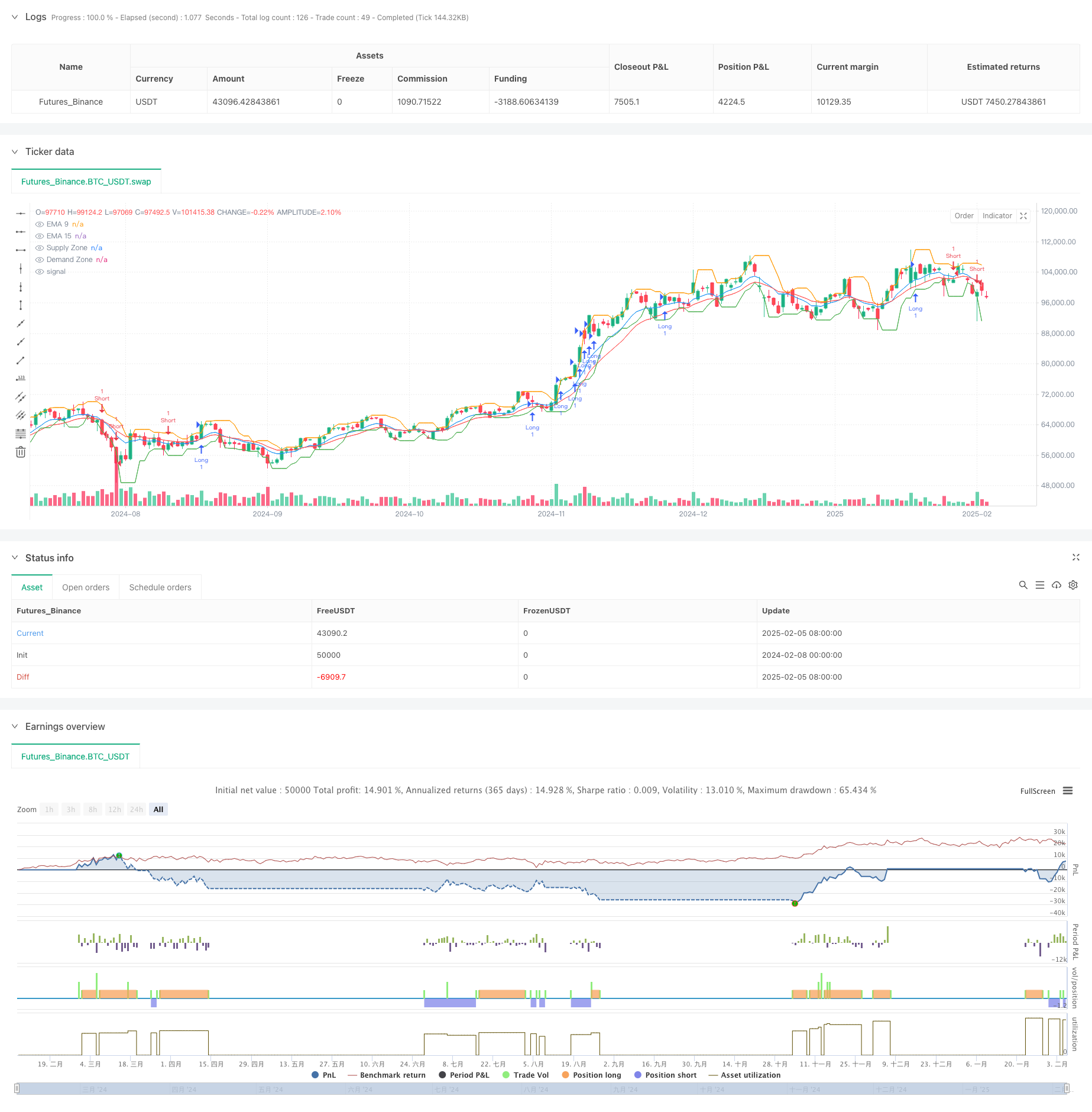
概述
该策略是一个结合了均线(EMA)、供需区域和交易量的高级自适应性套利策略。它通过多重技术指标的交叉确认来识别市场趋势,并在关键供需区域附近进行交易。策略采用动态止损和获利目标,通过ATR指标来适应市场波动性。
策略原理
策略的核心逻辑基于以下几个关键要素: 1. 使用9周期和15周期EMA的趋势方向作为主要交易信号 2. 通过更高时间框架(15分钟)的供需区域来确定重要价格水平 3. 利用交易量确认来验证趋势的有效性 4. 使用基于ATR的动态止损和获利目标来管理风险 5. 在多重条件同时满足时才进行交易
具体来说,当9周期EMA连续3个周期上升,15周期EMA也呈上升趋势,且价格位于需求区域之上,同时20周期交易量均线大于50周期交易量均线时,系统会发出做多信号。做空信号的逻辑相反。
策略优势
- 多重确认机制显著提高了交易的可靠性
- 动态的止损和获利目标能够适应不同的市场环境
- 通过供需区域的过滤来避免在不利的价格区域交易
- 交易量确认提供了额外的趋势验证
- 风险收益比可以根据市场情况灵活调整
- 策略具有良好的自适应性,适合不同的市场条件
策略风险
- 在高波动市场中可能会出现虚假信号
- 多重确认条件可能导致错过一些交易机会
- 供需区域的识别可能存在滞后性
- 在横盘市场中可能会产生频繁的交易信号
风险控制措施: - 使用动态ATR止损来适应市场波动 - 通过交易量确认来过滤虚假信号 - 实施严格的风险收益比控制 - 在关键价格区域附近进行交易
策略优化方向
- 引入自适应的EMA周期,使其能够根据市场波动性自动调整
- 添加市场状态识别模块,在不同市场环境下使用不同的参数
- 优化供需区域的计算方法,提高识别的准确性
- 加入更多的市场微观结构分析
- 开发动态的风险收益比调整机制
总结
这是一个融合了多个技术分析工具的完整交易系统,通过多重确认机制来提高交易的可靠性。策略的优势在于其自适应性和风险管理能力,但同时也需要注意在不同市场环境下的表现差异。通过建议的优化方向,该策略还有进一步提升的空间。
策略源码
/*backtest
start: 2024-02-08 00:00:00
end: 2025-02-06 08:00:00
period: 1d
basePeriod: 1d
exchanges: [{"eid":"Futures_Binance","currency":"BTC_USDT"}]
*/
//@version=5
strategy("Optimized Scalping Strategy with EMA & Supply/Demand Zones", overlay=true)
// Inputs
ema9_length = input(9, title="EMA 9 Length")
ema15_length = input(15, title="EMA 15 Length")
higher_tf = input.timeframe("15", title="Higher Timeframe for Zones")
atr_mult = input(1.5, title="ATR Multiplier for Stop Loss")
risk_reward = input.float(1.2, title="Risk-Reward Ratio", options=[1.2, 1.3, 1.4])
// Calculating EMAs
ema9 = ta.ema(close, ema9_length)
ema15 = ta.ema(close, ema15_length)
// Function to detect supply & demand zones
get_zone(tf) =>
high_tf_high = request.security(syminfo.tickerid, tf, ta.highest(high, 50))
high_tf_low = request.security(syminfo.tickerid, tf, ta.lowest(low, 50))
[high_tf_high, high_tf_low]
[supply_zone, demand_zone] = get_zone(higher_tf)
// ATR-based Stop Loss and Take Profit
atr = ta.atr(14)
long_sl = close - (atr * atr_mult)
long_tp = close + (atr * atr_mult * risk_reward)
short_sl = close + (atr * atr_mult)
short_tp = close - (atr * atr_mult * risk_reward)
// Entry conditions with volume and trend confirmation
longCondition = ta.rising(ema9, 3) and ta.rising(ema15, 3) and close > demand_zone and ta.sma(volume, 20) > ta.sma(volume, 50)
shortCondition = ta.falling(ema9, 3) and ta.falling(ema15, 3) and close < supply_zone and ta.sma(volume, 20) > ta.sma(volume, 50)
// Exit conditions using ATR-based SL/TP with additional trend confirmation
exitLong = (close >= long_tp or close <= long_sl) and ta.falling(ema9, 2)
exitShort = (close <= short_tp or close >= short_sl) and ta.rising(ema9, 2)
// Executing trades with improved risk management
if longCondition
strategy.entry("Long", strategy.long)
strategy.exit("Long Exit", from_entry="Long", stop=long_sl, limit=long_tp)
if shortCondition
strategy.entry("Short", strategy.short)
strategy.exit("Short Exit", from_entry="Short", stop=short_sl, limit=short_tp)
// Plotting
plot(ema9, color=color.blue, title="EMA 9")
plot(ema15, color=color.red, title="EMA 15")
plot(supply_zone, color=color.orange, title="Supply Zone")
plot(demand_zone, color=color.green, title="Demand Zone")
相关推荐